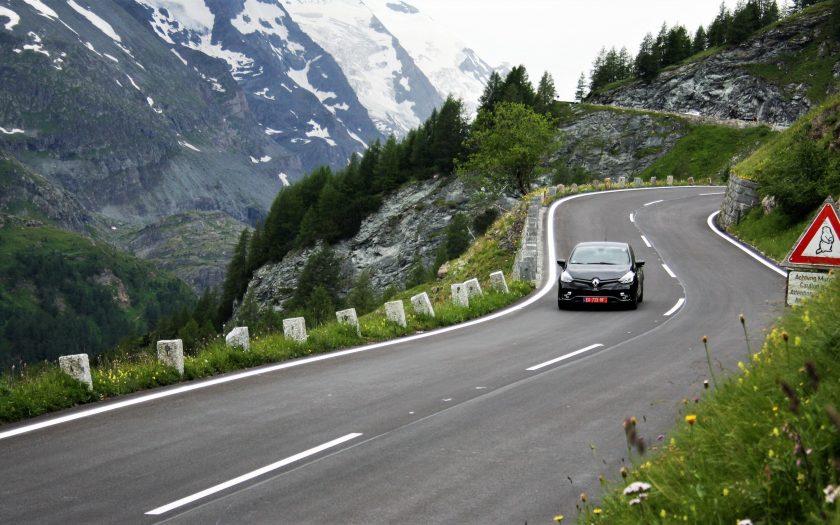Drive: Grossglockner Alpine Road, Austria, 48km
Car: 2018 Renault Sport R. S. 220 Clio Trophy
‘In te Domine speravi’ (I put my trust in you, Lord). I’m not the deeply religious type but, even so, this inscription above the Hochtor tunnel seems eerily profound. For it is here, on this fast, open section between Hochtor and the Mittertorl tunnel, where the Grossglockner high alpine road is at its most brazenly seductive, urging driver and rider to go for it. But, right here and now, with rain falling and traffic oncoming, maybe best not to forza.
Set alongside Austria’s tallest mountain of the same name, the Grossglockner is the highest surfaced road in the land at a peak of 2504m. In just 48km, this wondrous stretch of tarmac offers up a diversity of Pinterest opportunities, from gently rolling meadows and spicily scented alpine forest to bluff mountain faces and the imposing ice sheet of Austria’s longest glacier, the Pasterze.

There is a toll, worth every cent. A day pass costs €37 (about $A60) for a private car and a motorcycle €27 (about $A40). Access is during daylight hours only, from early May to early November, weather permitting.
But let’s start at the beginning… After two hours on the road from Cortina d’Ampezzo in northern Italy, it’s time to stop and stretch our legs. A roadside café with a backdrop of water cascading 130m down the mountain looks just the place, so with cappuccino in one hand and honey-drizzled pastry in the other we take a short stroll to check out the Jungfernsprung Waterfall.
A signboard alongside an imposing wooden statue tells the intriguing tale of how the name – Maiden’s Leap – came about. It goes that a local dairymaid leapt off the cliff next to the waterfall to escape the lecherous clutches of old St Nick himself. Miraculously, she survived unscathed, the devil dipped out and a wooden statue was crafted to perpetuate the myth.
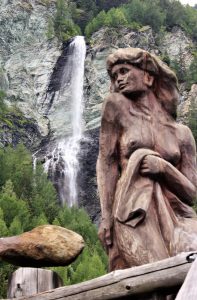
Back to reality. From the southern toll gate at Heiligenblut, the Grossglockner sweeps some 600m upwards to where the stunning scenery supersizes. We arrive at a roundabout; the high alpine road continues to the right while left leads to the Kaiser Franz-Josefs Höhe (KF-JH). We take the latter, following a narrower, tighter route clinging to the eastern side of the mountains and past the Glocknerhaus, where it ascends and curves through an open-sided tunnel onto the KF-JH.
Here is a visitor centre with access to interactive displays and exhibitions, eateries, the ‘world’s highest auto museum’, souvenir shops and glacier railway. It’s here also where you can get up close and personal with the mighty Grossglockner Mountain and the battleship-grey expanse of the Pasterze.
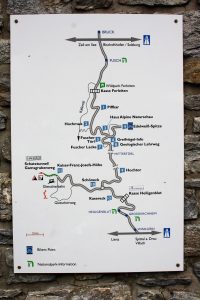
Back to the high alpine road, the rain that had been forecasted starts to tumble ominously as we traverse thick forest into a mesmerising succession of twisties, precursor to the earlier mentioned straight stretch through the Hoctor and Mittertorl tunnels, into Salzburg province from Corinthia.
At Fuscher Lacke, we resist the temptation to stop and refresh at the lakeside restaurant and push on, delighting in the broadening width of the smooth, hot-mix surface and accommodating, long line of sight through the curves. Next up is the Fuscher Törl and its memorial to workers who died building the road in the 1930s.
Here also is a turn-off to the Edelweißspitze, at 2571m, the high point of the pass. On a clear day, this lofty vantage point is reputed to offer an unrivalled panorama encompassing no less than 37 peaks and 19 glaciers, but not today – the thick, low cloud continues to rain on our parade.
Compensation is, we get to run over what remains of the Grossglockner’s historic cobblestone surface, a 2km-long corkscrew through seven tight hairpins, up and back. The rough surface sends a rumble through the cabin, but the intrusion is a mild trade-off for the Trophy’s track-focused suspension. Compared with a standard Clio, the rear springs are 40 percent stiffer, the dampers firmer and ride height lower by 20mm front and 10mm back; good stuff that makes the R.S. 220 such an accomplished bend-blitzer.
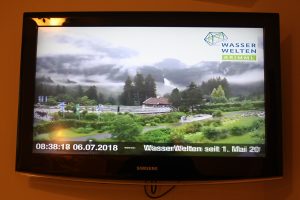
Retracing our treadmarks down the zigzag, we follow the high alpine road, dropping some 1.27km in altitude in just 13km. With no guard rail to help keep us on the black stuff and out of the abyss, caution is key. We cross a scree field dubbed Devil’s Kitchen, before the first of a forest of millennium-old larch trees breaks into sight along the Fuscher Valley. From here, it’s just a schlep to the northern toll gates at Ferleiten and to our overnight stay in the town of Fusch.
The rain stops just after we arrive, so we stroll down to a restaurant that looks characterful and popular, one with plenty of touring motorcycles parked outside. The restaurant delivers on its promise of the ‘das Willkommen’ sign out front, and it’s with a full stomach and a shine-up that we wobble home, huddled under a brolly. By now, the rain seems pretty damn set in.
Miraculously, though, we wake under a ceiling of mountain mist and low cloud, but no wet stuff tumbling down. That said, pictures beaming into our hotel room from CCTV up on the Grossglockner paint a grim picture.
Surprisingly, conditions out of Ferleiten up to Fuscher Törl are not too bad, and we get to execute a succession of narrow corners and switchbacks at a fairly dry pace. But, as expected, the higher we get, visibility drops, and the road is awash. With the traction control light blinking, it’s time to back off on descent to Fuscher Lacke. And the long and winding, open road up to the Mittertorl tunnel that had incited notions of redline chasing the day before, receives due circumspection.
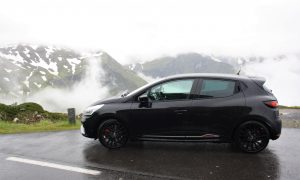
Inclemency has also allowed the little Renaultsport to show a depth of ability it might not otherwise have. That afore-mentioned stiff suspension and track-biased, 18-inch Michelin Pilot Super Sport rubber are working surprisingly well in such low-grip conditions; ditto the sharp steering and power delivery, neither creating any drama.
Obviously, I had toned things down with the R.S. Drive, but at no stage did we feel a compulsion to start reciting the prayer from up there on the Hochtor tunnel entrance. By driving to the conditions, I’m relishing the challenge.
Unlike a lot of mountain passes the world over, the Grossglockner’s generous width offers plenty of passing opportunities, which is just as well given its popularity as one of the great scenic drives. With 36 hairpins and layered in smooth hot-mix bitumen, it well-lives up to its reputation as a veritable high road to heaven for driving and riding (cycle and motorcycle) diehards.
Basic price new: $A42,990
Engine: 1.6-litre turbo DOHC 16v inline 4-cyl
Power: 162kW @ 6050rpm
Torque: 260Nm (280 on over-boost) @ 2000rpm
Transmission: 6-spd dual-clutch auto
Weight 1204kg
Drive: Front-wheel
0-100km/h: 6.6sec
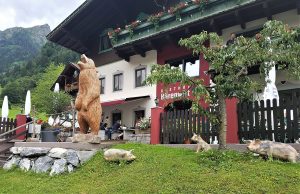
Story Behind the Story
History and sense of occasion pervade the Grossglockner. To traverse its 48km length is to drive in the mule tracks of Romans and Celts crossing the Alps and follow the footsteps of earlier humanity as far back as 5000 years ago.
Construction on the road as we know it started with the detonation of explosives on August 30, 1930, and some 4000 workers set about their arduous toil. Twenty-seven days short of five years later, the road was inaugurated. Within just 24 hours, the first motor race was conducted on a 19km section of compacted gravel and sand, where Italian ace Mario Tadini, in a Scuderia Ferrari Alfa, took Fastest Time of the Day.
Then followed the Grossglockner’s chapter of the legendary Silver Arrows era, when the road would close for a day and the still, crisp mountain air reverberated to the roar of huge, supercharged Mercedes V12 and Auto Union V16 openwheelers, hurtling one at a time towards the summit at Kaiser Franz-Josefs Höhe.
Works teams from both marques fronted in 1938, the German Mountain Championships; Hans Stuck for Auto Union and Hermann Lang and Manfred von Brauchitsch for Mercedes. With many of the switchbacks now cobbled, heavy rain forced the event to be run in two stages. When times were totalled, Stuck was deemed the winner from Lang and von Brauchitsch.
What times they were, both in terms of the incredible runs in the most adverse of conditions, and in terms of when the fastest and fearless lived and drove.
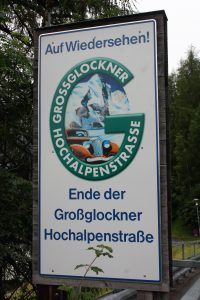
Barry Green will be well-known to many of you and a welcome discovery for those of you who haven’t been reading his words for years.
He has had an illustrious five-decade-long career writing for such titles as Racing Car News, Sports Car World as well as holding professional journalist roles with Australian Provincial Newspapers and News Limited and motoring writer and editor of the RACQ’s Road Ahead magazine. Along the way he found time to write and self-publish a trilogy of retro motor sport narratives – Driven to Succeed (the biography of Alec Mildren), Longford: Fast Track Back and Glory Days (the Albert Park story from 1953 to 1958).
Now you can revel in his recollections of more than 80 drives of an eclectic mix of machinery on some of the world’s finest roads and racing circuits.
